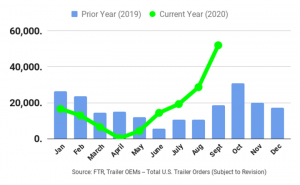BLOOMINGTON, Ind. — FTR reported Oct. 12 that preliminary U.S. net trailer orders for September exploded to the third-highest month ever, at 52,000 units. September’s orders were 23,500 units above August 2020 and 33,400 more than September 2019. With this latest activity, trailer orders for the last 12 months now equal 224,100 units.
 The majority of September orders were for dry vans, FTR noted, adding that refrigerated van orders were also comparatively robust and flatbed orders are expected to continue a sluggish recovery. Backlogs are predicted to jump back up to December 2019 levels. The strong order totals from the past two months should push production up to pre-pandemic levels in the year’s fourth quarter, with more increases expected starting early next year.
The majority of September orders were for dry vans, FTR noted, adding that refrigerated van orders were also comparatively robust and flatbed orders are expected to continue a sluggish recovery. Backlogs are predicted to jump back up to December 2019 levels. The strong order totals from the past two months should push production up to pre-pandemic levels in the year’s fourth quarter, with more increases expected starting early next year.
“There is expansion demand, replacement demand, dealer demand — just an enormous amount of demand for dry vans to keep consumer goods on the move,” said Don Ake, vice president of commercial vehicles for FTR. “Fleets are expecting the hot freight market to continue into 2021 and want to be prepared with adequate capacity. Reefer demand should also continue to be strong, and benefit from more restaurant activity as 2021 progresses.
The Congressional stimulus package passed in March infused a tremendous amount of funds into the economy, and this cash is being spent overwhelmingly in the consumer goods sector, as the service sector remains constrained during the pandemic, according to a statement from FTR. This has boosted dry van freight, constraining capacity, and lifting freight rates. Fleets have responded by ordering dry vans in near-record quantities. Also, despite reduced restaurant sales, many consumers have more disposable income available to spend on food, which is helping reefer sales.
“This appears to be a repeat of late 2018, when fleets ordered trailers in record numbers in September and October because of tight capacity and perceived limited build slots at the OEMs,” Ake said.
“There could be some irrational exuberance behind orders this high. Fleets are expecting the current conditions to continue well into 2021, and this may not be the case,” he warned. “The trailer market has seen incredibly wide swings in 2020 and it is difficult to determine how long the current momentum can last. Orders may stay elevated if fleets compete to lock up future build slots as they did in 2018 and 2019.”
The Trucker News Staff produces engaging content for not only TheTrucker.com, but also The Trucker Newspaper, which has been serving the trucking industry for more than 30 years. With a focus on drivers, the Trucker News Staff aims to provide relevant, objective content pertaining to the trucking segment of the transportation industry. The Trucker News Staff is based in Little Rock, Arkansas.















